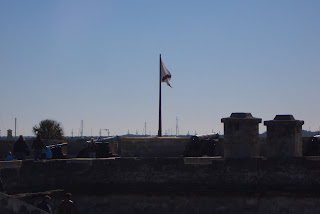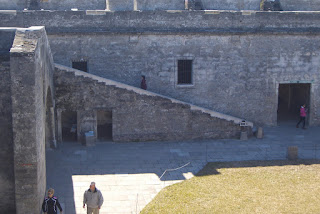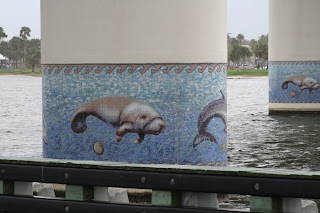Friday, January 28, 2011
This is the signs they have everywhere because this is the manatee area and you need to slow down. they are not around now because it is too cold and they go in the springs where the water is warmer.
 Going down the little canal towards Titusville, FL around 5 miles from the shuttle launch which we hope to see.
Going down the little canal towards Titusville, FL around 5 miles from the shuttle launch which we hope to see.
 Going down the little canal towards Titusville, FL around 5 miles from the shuttle launch which we hope to see.
Going down the little canal towards Titusville, FL around 5 miles from the shuttle launch which we hope to see.Thursday, January 27, 2011
Pelicans Feeding in Titusville, FL
Escorting Dolphins
Wednesday, January 26, 2011
Daytona Beach, FL
Ross is riding his bike on the beach of Daytona, FL what a wonderful beautiful sunny day.
 Here I am riding my bike on the beach of Daytona Beach, FL
Here I am riding my bike on the beach of Daytona Beach, FL
Fort Matanzas National Monument
Coastal Florida was a major field of conflict as European nations fought for control in the New World. As part as this struggle, Fort Matanzas guarded St. Augustines's southern river approach. The colonial wars are over, but the monument is still protecting not just the historic fort, but also the wild barrier island and the plants and animals who survive there.
 This is the site of the killing of nearly 250 French Huguenots by the Spanish, an act that the river and inlet the name Matanzas. , Spanish for "slaughters", as European nations fought for control of the New World.
This is the site of the killing of nearly 250 French Huguenots by the Spanish, an act that the river and inlet the name Matanzas. , Spanish for "slaughters", as European nations fought for control of the New World.
 This is the site of the killing of nearly 250 French Huguenots by the Spanish, an act that the river and inlet the name Matanzas. , Spanish for "slaughters", as European nations fought for control of the New World.
This is the site of the killing of nearly 250 French Huguenots by the Spanish, an act that the river and inlet the name Matanzas. , Spanish for "slaughters", as European nations fought for control of the New World.Sunday, January 23, 2011
Castillo San Marcos National Monument
Ross on the waterfront wall. We dingy over to St. Augustine to go see the Castillo de San Marcos National Monument.
 Here is Ross with "Cool Change" in the background on the left.
Here is Ross with "Cool Change" in the background on the left.

Here I am with "Cool Change" in the background.

The Castillo de San Marcos National Monument.
 The old Spanish flag (1505-1785) also called the Cross of Burgundy it was introduced in Spain by the marriage of Philip Duke of Burgundy. to Juliana daughter of King Ferninand and Queen Isabella.
The old Spanish flag (1505-1785) also called the Cross of Burgundy it was introduced in Spain by the marriage of Philip Duke of Burgundy. to Juliana daughter of King Ferninand and Queen Isabella.

Spanish Flag flies.

 This is a view from the top looking into the courtyard of the fort.
This is a view from the top looking into the courtyard of the fort.
 Another corner of the fort. There was a chapel because religion was important in Spanish daily life. Some of these rooms look like a prison but they were storage ares. The Spanish stored gunpowder, ammunition, weapons, lumber, tools, and food like dried beans, rice, flour, and corn. Since St Augustine was not self-sufficient, such stockpiles of food and ammunition were an important part of the town's defense during a siege.
Another corner of the fort. There was a chapel because religion was important in Spanish daily life. Some of these rooms look like a prison but they were storage ares. The Spanish stored gunpowder, ammunition, weapons, lumber, tools, and food like dried beans, rice, flour, and corn. Since St Augustine was not self-sufficient, such stockpiles of food and ammunition were an important part of the town's defense during a siege.

Each of the fort's four corners is protected by a diamond-shaped bastion. Cannons in one bastion were positioned to create a deadly crossfire with those in two other bastions. The bastion's thick stone walls were packed solid with rubble and sand to support the immense weight of the cannon.


 Ready, Aim, Fire!!!!!!!!!!!!!!!
Ready, Aim, Fire!!!!!!!!!!!!!!!

You can see the different angles of the fort. The protrusions are the bastions.

Ross entering the Castillo de San Marcos. It is like a draw bridge. You can see the chains on the sides.

 Side view of the shot furnace. They would heat the cannon balls until red hot then fire at the enemy's wooden ships to set them on fire.
Side view of the shot furnace. They would heat the cannon balls until red hot then fire at the enemy's wooden ships to set them on fire.
 Front view of the shot furnace.
Front view of the shot furnace.


Here I am with "Cool Change" in the background.
The Castillo de San Marcos National Monument.
Spanish Flag flies.
No one lived inside the Castillo. The soldiers lived in town with their families and came to the fort to stand a rotating guard duty (usually 24 hours). At such times, they slept and prepared their meals in these rooms. These were the beds for the soldiers.
Each of the fort's four corners is protected by a diamond-shaped bastion. Cannons in one bastion were positioned to create a deadly crossfire with those in two other bastions. The bastion's thick stone walls were packed solid with rubble and sand to support the immense weight of the cannon.
This is the ocean view from the Castillo San Marcos. You can see how the Spanish would have the advantage. The wall was made of coquina (is a sedimentary rock made up of shells, shell fragments, and skeletons of small marine creatures).
You can see the different angles of the fort. The protrusions are the bastions.
Ross entering the Castillo de San Marcos. It is like a draw bridge. You can see the chains on the sides.
U.S. Shot Furnace
This structure is a hot shot furnace for heating cannon balls to be shot at wooden vessels and to set them on fire. It is part of the water battery built by the U.S. (1842-44) when this side of the moat was filled and the guns were mounted on the stone arcs behind the sea wall.
Here I am with the guys who did the reinactment they fired off the cannon out into the ocean as if they were fighting off the pirates.
 Marching off after the cannon firing.
Marching off after the cannon firing.

A young boy playing the drums in an reinactment.

 This is what the view looks like out of one of the sentry boxes. You can see clear across the harbor. The troops could look out for oncoming enemies while keeping sheltered from the elements.
This is what the view looks like out of one of the sentry boxes. You can see clear across the harbor. The troops could look out for oncoming enemies while keeping sheltered from the elements.

Sentry box close up.

Before the construction of the Castillo, the people of St. Augustine were perioidically raided by pirates. Since the town was never prosperous anyway, the loss of what little there was, meant heard times and near starvation for all.

San Agustin Bastion. (This is how the Spanish people spelled Agustine)


This is a nice Spanish cannon. Many cannons were very ornante with different scroll designs on them.


The cannon facing the ocean harbor ready to defend the fort against invaders.

The cannons lined up in a row ready to defend the fort of Castillo San Marcos.

 Ross by one of the cannons .
Ross by one of the cannons .
 Ross examing one of the many cannons they had on display .
Ross examing one of the many cannons they had on display .

Castillo San Marcos National with the sentry box in the background. On of the Bastion shelter boxes.

Although the Castillo high walls and moat were a substantial obstacle to anyone trying to capture the fort, the cannon here on the gundeck, were the real strength of the fort. With a range of over a mile, the cannon could strike at ships in the harbor as well as soldiers on land. The Spanish kept the land cleared of trees for 250 yards beyond the fort so that approaching troops had no natural cover or protection. In 1763 the fort had 77 guns.
Ross is in the "Sentry Box" this is where the soldiers stayed to protect themselves from the elements, while guarding the fort. There are four of these on each corner with different names, San Carlos Bastion, San Agustin Bastion, San Pedro Bastion and San Pablo Bastion. A bastion is a structure projecting outward from the main enclosure of a fort, situated in both corners of a straight wall which is the defence against assaulting troops. It allows the defenders of the fort to cover adjacent bastions and curtains with defensive fire. The bastion was designed to offer a full range on which to attack oncoming troops. They used the cannons to concentrate on oncoming targets.
Sentry box close up.
Before the construction of the Castillo, the people of St. Augustine were perioidically raided by pirates. Since the town was never prosperous anyway, the loss of what little there was, meant heard times and near starvation for all.
San Agustin Bastion. (This is how the Spanish people spelled Agustine)
This bastion was named after the patron saint of the city. St Augustine was established in 1565, 42 years before the English settled Jamestown. 55 years before the Pilgrims stepped onto Plymonth Rock. It grew from 800 people in 1565 to to 3, 000 in 1763, the end of the first Spanish occupation.
This is a nice Spanish cannon. Many cannons were very ornante with different scroll designs on them.
The cannon facing the ocean harbor ready to defend the fort against invaders.
The cannons lined up in a row ready to defend the fort of Castillo San Marcos.
Here I am in my winter garb it was really cold up on the fort but hey take a look at the palm trees in the background.
Castillo San Marcos National with the sentry box in the background. On of the Bastion shelter boxes.
Although the Castillo high walls and moat were a substantial obstacle to anyone trying to capture the fort, the cannon here on the gundeck, were the real strength of the fort. With a range of over a mile, the cannon could strike at ships in the harbor as well as soldiers on land. The Spanish kept the land cleared of trees for 250 yards beyond the fort so that approaching troops had no natural cover or protection. In 1763 the fort had 77 guns.
Subscribe to:
Posts (Atom)
























